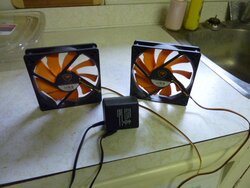Well tonight I took a leap of faith and told the wife my ideas for distributing heat around the house. She's already used to a few fans but last night she said "yes" to a vent so long as she can pick it out and a professional installs it so as not to mess up the plaster walls (we'll see).
This is the video of my house layout I shots months ago before I actually had my BK Insert installed:
I have been using fans on the floor to move cold air into the living room as opposed to using fans in the living room to move heat out. It works well for the bedrooms, but I am very worried it will not get any heat into the kitchen and more importantly the sunroom.... which happens to be the room farthest from the stove and all windows. Doh!
So last night I told my wife that as it gets colder it may get more difficult to move heat into the sunroom (where the pets stay all day when we are at work). Yes, the room heats up when it is sunny out, but not enough and on a cloudy date it's going to be cold (without turning on the NG boiler).
I want to put in a vent (passive? active?) through the kitchen (about the 28 second mark of the video) to the living room (as high up on the wall to the right of the stove at the 1:03 mark) to allow how air to flow into the kitchen and sunroom area.
Questions:
- Passive or Active? Any really quiet Active you recommend?
- I have plaster and lathe walls. Am I going to put spider cracks (or worse) all over the wall my cutting into it? How much of a PIA will this vent be?
Thanks!
This is the video of my house layout I shots months ago before I actually had my BK Insert installed:
I have been using fans on the floor to move cold air into the living room as opposed to using fans in the living room to move heat out. It works well for the bedrooms, but I am very worried it will not get any heat into the kitchen and more importantly the sunroom.... which happens to be the room farthest from the stove and all windows. Doh!
So last night I told my wife that as it gets colder it may get more difficult to move heat into the sunroom (where the pets stay all day when we are at work). Yes, the room heats up when it is sunny out, but not enough and on a cloudy date it's going to be cold (without turning on the NG boiler).
I want to put in a vent (passive? active?) through the kitchen (about the 28 second mark of the video) to the living room (as high up on the wall to the right of the stove at the 1:03 mark) to allow how air to flow into the kitchen and sunroom area.
Questions:
- Passive or Active? Any really quiet Active you recommend?
- I have plaster and lathe walls. Am I going to put spider cracks (or worse) all over the wall my cutting into it? How much of a PIA will this vent be?
Thanks!



 .
. 
 Make sure nothing is behind wall wiring. pipes. 2x4s etc. Take a drill and drill a small hole in center, take old coat hanger or straight piece of wire bend it to L shape the size just a little bigger than the cut work the L shape end in the hole turn it in a circle and play with the wire to see if all is clear..Drill threw the back wall too, If bit is long enough. If not do your cut out on one side of wall then drill some really small holes from the cut out side of wall to out line the other side wall curt back of wall the same as the first cut out.from the other side, Dont try to measure from the other side if wall. You will come up with an off set to the first cut out.
Make sure nothing is behind wall wiring. pipes. 2x4s etc. Take a drill and drill a small hole in center, take old coat hanger or straight piece of wire bend it to L shape the size just a little bigger than the cut work the L shape end in the hole turn it in a circle and play with the wire to see if all is clear..Drill threw the back wall too, If bit is long enough. If not do your cut out on one side of wall then drill some really small holes from the cut out side of wall to out line the other side wall curt back of wall the same as the first cut out.from the other side, Dont try to measure from the other side if wall. You will come up with an off set to the first cut out.